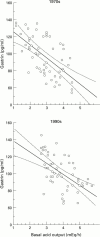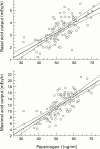Helicobacter pylori independent chronological change in gastric acid secretion in the Japanese
- PMID: 9391241
- PMCID: PMC1891514
- DOI: 10.1136/gut.41.4.452
Helicobacter pylori independent chronological change in gastric acid secretion in the Japanese
Abstract
Background: Gastric acid secretion in Japanese subjects decreases with aging. One of the possible causative mechanisms of this attenuated acid secretion is speculated to be a Helicobacter pylori induced chronic gastritis. The infection rate of this microorganism has decreased recently in Japan.
Aims: To investigate whether gastric acid secretion has altered over the past 20 years, and if so, what the influence of H pylori infection might be in the Japanese population.
Subjects and methods: Gastric acid secretion, serum gastrin and pepsinogen I and II concentrations, and H pylori infection were determined in 110 Japanese subjects in both the 1970s and 1990s.
Results: Basal acid output as well as maximal acid output have greatly increased over the past 20 years, not only in individuals with H pylori infection but also in those without infection. Furthermore, subjects with H pylori infection tended to show decreased gastric acid secretion in comparison with those without infection, particularly in geriatric subjects. There was a positive correlation between gastric acid secretion and serum pepsinogen I concentrations.
Conclusions: In Japan, both basal and stimulated gastric acid secretion have increased over the past 20 years; some unknown factors other than the decrease in H pylori infection may play an important role in this phenomenon.
Figures







Comment in
-
The aging stomach or the stomachs of the ages.Gut. 1997 Oct;41(4):575-6. doi: 10.1136/gut.41.4.575. Gut. 1997. PMID: 9391266 Free PMC article. No abstract available.
References
Publication types
MeSH terms
Substances
LinkOut - more resources
Full Text Sources
Other Literature Sources
Medical
Miscellaneous
